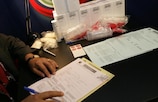Anti-doping programme on course to achieve goal
Friday, February 7, 2014
Article summary
UEFA's anti-doping effort was highlighted at the UEFA Medical Symposium in Madrid – and activities within this key programme will continue to protect football's integrity.
Article top media content

Article body
One of UEFA's long-standing initiatives for protecting the integrity of the game – the European governing body's anti-doping programme – has been a key element of discussions at this week's sixth UEFA Medical Symposium in Madrid.
UEFA's commitment to the fight against doping has always been a priority, with various ground-breaking developments being implemented, such as out-of-competition testing, blood testing and player whereabouts management. In 2014, the UEFA programme remains one of the most comprehensive in world football – an undertaking carried out in close consultation with key partners such as the European national anti-doping organisations, World Anti-Doping Agency (WADA) accredited laboratories and WADA itself.
The coming year will herald a new chapter in the programme's evolution, with the publication of the results of UEFA's steroid profile study conducted in collaboration with the WADA-accredited laboratory in Lausanne.
The study analyses the steroid profiles of almost 900 players who have been tested at least three times in UEFA competitions since 2008, and although results are anonymous and will not lead to the imposition of anti-doping rule violations, they will still provide a unique insight into the potential prevalence of steroid use throughout European football.
UEFA's carefully planned and distributed urine and blood-testing programme will also continue across all competitions, to ensure that players are both deterred from doping and detected if they do choose to try and cheat. All in all, the aim is clear – to leave no place for cheating in football and to make sure that UEFA tournaments are underpinned by the notion of fair play. UEFA's advanced programme remains in position to achieve this goal.









